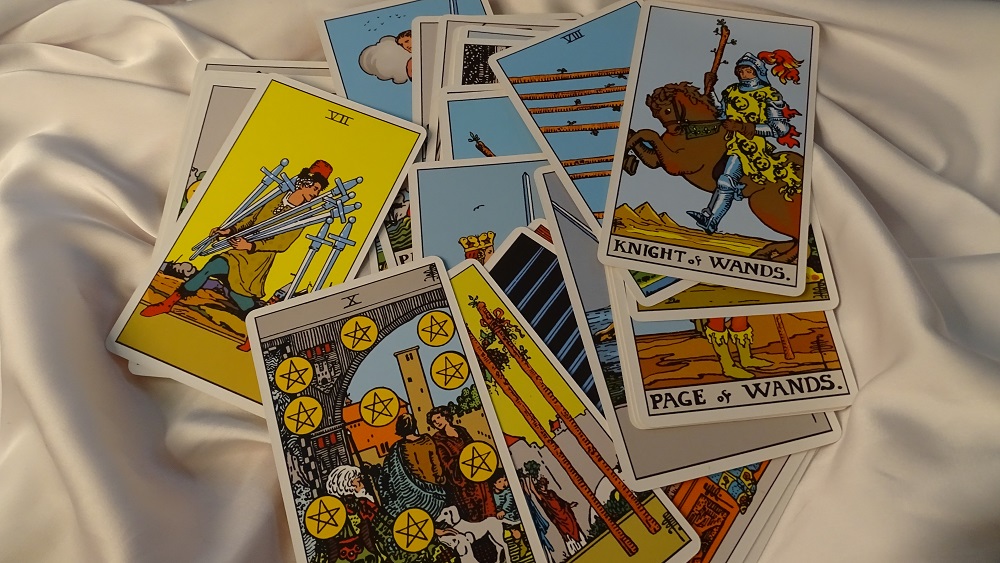What is Authentic Rider-Waite Tarot Deck?
Characteristic of Rider-Waite Tarot Deck
Author: Arthur Edward Waite
Artist: Pamela Colman Smith
Traditions: English School (Arthur Waite)
Numbering: The Fool 0 Strength 8 Judgment 11
Minor arcana: illustrations
Suits: wands, cups, swords, pentacles
Court Cards: Page, Knight, Queen, King
Deck type: universal, for beginners
HISTORY
The Ryder-Waite Tarot is one of the most popular Tarot deck design. It was developed in 1910 by Arthur Edward Waite, a famous researcher of Freemasonry, Kabbalah and mystical teachings, a prominent member of the Order of the Golden Dawn. The drawings of the cards were done under the direction of Waite by the American-born English artist Pamela Coleman-Smith, who was also a member of the order. The first publisher of the deck was William Ryder (London), thus the deck was named after the name of the publisher and the main author. The author’s explanation of the symbolism and interpretation of the deck cards is presented in the work of Arthur Waite “The Illustrated Key to the Tarot”.
PECULIARITIES
From the point of view of the structure, the main feature of the deck is that Waite changed the position of Major Arcana XI and VIII in it: he assigned the ordinal number XI to the Arcana “Justice“, and the ordinal number VIII to the “Strength“. Waite himself never explained the reasons for this change. Although in most decks that later were modeled after Waite’s deck, the eighth and eleventh arcana are returned to their original positions.
In Waite’s deck, the symbolism of the Major Arcana VI “The Lovers” has been updated. The card shows a biblical painting: naked Adam and Eve in paradise. Traditionally, this card is associated with the archetype “knight at the crossroads”. When fortune-telling, it primarily symbolizes an important life choice. Waite has completely eliminated the theme of choice, and only the theme of love and everything connected with it (attraction, sex, passion, original sin, and so on) remained. By the way, this interpretation of the sixth Arcana is not generally accepted, many modern tarologists, even using the Waite deck, prefer to keep the traditional interpretation of “Lovers”, at least in matters not related to feelings and relationships.
For the first time, the numbered Minor Arcana were equipped with images that had a specific plot, such as images of the Major Arcana, which made it possible to use these plots in fortune telling as a source of possible variants of the card’s meaning. Until then, only signs of suits in the appropriate number were depicted on digital Minor cards, and interpretations were based on a combination of an element corresponding to a suit and the numerological interpretation of the numerical value of the card.
ARTISTIC VIEW
Despite the fact that the drawings are made simply, one might say that in a childish way, the characters, details, the background – all this contains a lot of symbols. The authors focused on the earliest known Tarot patterns, but often added his own details. In his choice of symbols, Waite was mainly guided by the works of the magician and occultist of the XIX century Eliphas Levi.
The Ryder-Waite deck had a huge impact on artists and occultists who created their decks later. A significant part of the decks that appeared later can even be considered “clones”. A person that is familiar with Waite’s deck will easily recognize the characters, plots and symbols depicted on them.
The Tarot deck of Ryder-Waite was created for an easy understanding by ordinary people, far from magic, Kabbalah and astrology. This is the first deck in which all 78 cards were drawn with plots, rather than schematic symbols. This is what conquered the hearts of millions of people, because it is possible not to know and not to memorize the meanings of the cards, because everything is drawn on them.
Discover more from Esoteric Hut
Subscribe to get the latest posts sent to your email.


With your site I start to understand more about readings
You are welcome, and enjoy my articles!
An all-time classic.
The Rider-White deck is the most popular today, undoubtedly working, classic, and if you are about to learn Tarot cards, it is best to start with this deck.
Hello.This post was extremely interesting, particularly since I was investigating for thoughts on this issue last couple of days.
Thank you!!!
If you have not yet decided which deck to choose and are just starting to learn tarot fortune-telling, then it is best to take this classic deck. Logical, well designed, thoughtful, it is great for learning the basics of fortune telling and philosophy…